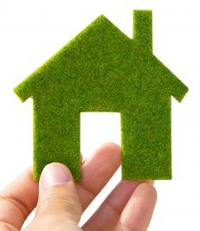No Obligation and transparency 24/7. Instantly compare live rates and costs from our network of lenders across the country. Real-time accurate rates and closing costs for a variety of loan programs custom to your specific situation.

“Green” homes can be great for the environment and can save you money over time. For environmentally-conscious homeowners wanting to minimize their footprint and their energy bills, there are four areas upon which to focus.
According to the Environmental Protection Agency (EPA), as of December 2012, buildings account for 68 percent of the nation’s total energy consumption. Green homes can reduce this figure via energy-efficient appliances; well-sealed, double-glazed windows; and good insulation. Alternative energy sources such as solar panels can also reduce energy use.
A green home has a smaller carbon footprint since it is built with better insulation and fitted with energy-efficient appliances.
Building materials are determined to be “green” based on manufacturing, shipping, and reclamation procedures, and are composed of renewable resources. Reclaimed materials such as wood from an old barn; or recovered newspapers for use in insulation are often considered to be green.
Green structures are built from sustainable or recycled materials that are meant to lower the impact on the environment. Proper green buildings also take advantage of natural lighting and airflow to reduce the use of electricity to light and to help warm and cool their interiors.
Counter-tops made from recycled materials are often considered green, too. Ceramic tiles, because of how much energy is required to form them, are often not considered green unless reclaimed from a demolition project.
A home for which the main living areas are facing south will be warmed by the sun in winter, and will not be overheated by the sun in summer. This is considered “green”, as is proper window placement which allows for cross-breezes which can lower energy costs on warmer days. Living in proximity to work and other frequented spots can reduce automotive energy consumption, too.
Good air quality means promoting a safe, toxin-free environment. Many conventional buildings are not properly ventilated and indoor air quality is often more polluted than the air outside.
Poor air quality is bad for your health and can aggravate asthma and allergies. Certified green properties tend to have excellent airflow and ventilation. They also use toxin-free materials in buildings and may have fewer problems with mold and mildew.
Using non-toxic paints in your home plus other green materials can improve air quality. Most notably because, over time, synthetic paints and materials break down, releasing harmful particles into the air.
When buying a green home, be sure to ask questions of the seller including how the home was built, which materials were used in construction, and whether the home’s appliances are Energy Star-rated.
Green buildings are constructed to use less energy, which means you should pay less in energy costs. Ventilation systems in green structures are better insulated to reduce air leakage.
Builders also install fixtures that conserve water and are energy efficient. The initial cost might be slightly higher, but the monthly bills can be cut almost in half in many cases.
There are even more financial, environmental, and health benefits to owning a green property. Living in a green home can allow you to save yourself money and help the earth, all while living in a healthy environment.
Are you curious about mortgages, or are you ready to apply for one to buy a home? If so, Sammamish Mortgage can help. We are a local mortgage company from Bellevue, Washington, serving the entire state, as well as Oregon, Idaho, and Colorado. We offer many mortgage programs to buyers all over the Pacific Northwest and have been doing so since 1992. Contact us today with any questions you have about mortgages.


Whether you’re buying a home or ready to refinance, our professionals can help.
{hours_open} - {hours_closed} Pacific
No Obligation and transparency 24/7. Instantly compare live rates and costs from our network of lenders across the country. Real-time accurate rates and closing costs for a variety of loan programs custom to your specific situation.